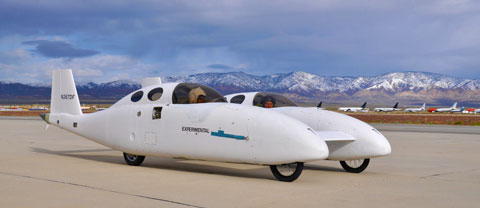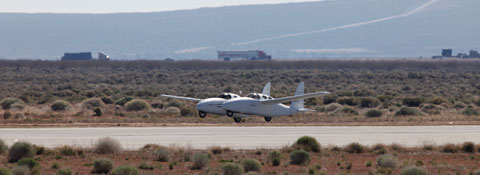
General aviation design legend Burt Rutan may have announced his retirement, but he’s continuing his innovative work. At a forum presentation July 27, Rutan expanded on his latest work: a hybrid-powered flying car.
“Ten years ago, I decided to let the younger engineers at Scaled Composites do the design work,” he said. “And even though SpaceShipOne was my last design, back in 2000, I thought, ‘I gotta do one more.’”
The result is the BiPod, a research project that Rutan is advancing in order to determine the feasibility of developing hybrid-powered flying cars. Another goal was to introduce Rutan’s younger designers to “old school” methods (using pencils, slide rules, and paper drawings) as an alternative to their usual reliance on computer-assisted design (CAD) methods. “CAD slows down design progress,” Rutan said. “It makes you miss deadlines.”
A team of 20 engineers was assigned to the BiPod project, and the car/airplane achieved a first, brief flight back in April 2011. BiPod stands for “Burt’s innovative project overtakes Dano,” a playful jab at engineer Daniel Craig, a staffer with a penchant for flying cars.
“We know how to build airplanes,” he said. “That’s easy. But a flying car? Most of those designs can barely fly. So we wanted to see if we could build a hybrid-powered model that would be a good airplane—one that could fly over the Rockies and have good range.”
The all-fiberglass design has a 31.8-foot wingspan, twin-boom fuselages that carry one occupant each (the pilot flies from the right fuselage), and twin pusher propellers. Each 32-inch-diameter propeller is driven by a six-pound, 20-horsepower electric motor, which is powered by 16 lithium ion phosphate batteries bearing 24 cells. The batteries are charged by a four-stroke motorcycle engine. The car/airplane currently has a takeoff weight of 1,430 pounds—which includes 18 gallons of auto fuel for the motorcycle engine.
The BiPod was not on display at EAA AirVenture.

In auto mode, the wings are folded and the rear wheels are powered by their own electric motor. In urban use, the BiPod should turn in a range of 35 miles using electric power only; at 65 mph on highways, a range of 820 miles is predicted. The motorcycle engine can be used to augment the electric power for high power output, in which case fuel consumption is projected as 46 mpg.
Rutan said that the BiPod should be able to take off and land within 400 feet, cruise as fast as 197 mph at 12,000 feet, and fly as far as 760 miles at an economy power setting. So far, ground effect flights have been conducted, with takeoff power provided by both the propellers and the wheel motors. But Rutan said he doesn’t know if the project will move on to a more extensive flight testing phase.
“I’m not in the business. I don’t have it in me to do another kit,” he said.
Rutan recently moved from California to Coeur D’Alene, Idaho. But when pressed, he was coy about his retirement there. “When I left Mojave, I left all but three pieces of furniture there—and one of them was my drafting board…hey, I’ve made a design a year since 1973,” he said. “Do you expect me to stop now? Remember, you don’t hear about my designs until they’ve flown.”



